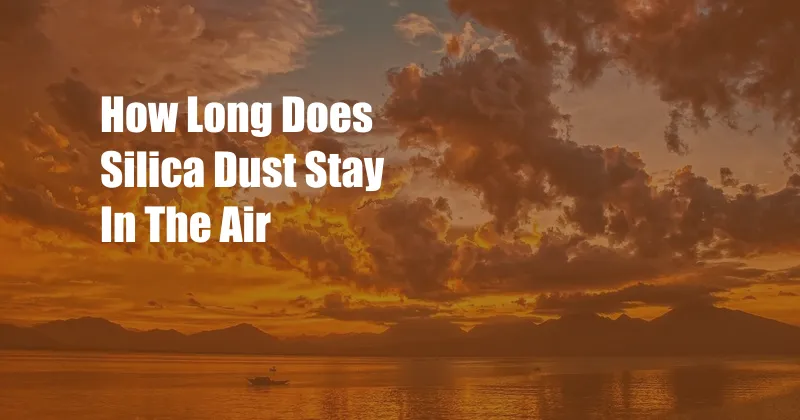
How Long Does Silica Dust Stay in the Air?
As a construction worker, I have seen firsthand the dangers of silica dust. This fine dust can cause serious health problems, including silicosis, a deadly lung disease. I remember a co-worker who developed silicosis and had to leave the construction industry. He was a great guy who was always willing to help others. It was heartbreaking to see him suffer.
That’s why I’m always careful to wear a respirator when I’m working in areas where there is silica dust. I know that silica dust can stay in the air for a long time, so I want to make sure I’m protected.
How Long Does Silica Dust Stay in the Air?
Silica dust is a type of particulate matter (PM) that is composed of tiny particles of silicon dioxide. Silica is a mineral that is found in many types of rocks, sand, and soil. When these materials are disturbed, silica dust can be released into the air.
The size of silica dust particles can vary greatly, from a few nanometers to hundreds of micrometers. The smaller the particles, the longer they can stay suspended in the air. Particles that are less than 10 micrometers in diameter are considered to be respirable, meaning that they can be inhaled deep into the lungs.
Silica dust can stay in the air for a long time, especially in indoor environments. In still air, silica dust particles can remain suspended for several hours. However, in windy conditions, silica dust particles can be transported long distances.
Health Effects of Silica Dust
Silica dust is a serious health hazard. Inhaling silica dust can cause a number of health problems, including:
- Silicosis
- Lung cancer
- Chronic obstructive pulmonary disease (COPD)
- Kidney disease
- Autoimmune diseases
Silicosis is the most common health problem caused by silica dust exposure. Silicosis is a progressive lung disease that can lead to disability and death. Silicosis develops when silica dust particles are inhaled deep into the lungs and become trapped in the alveoli, the tiny air sacs in the lungs. Over time, the silica dust particles can damage the alveoli and cause scarring. This scarring can make it difficult for the lungs to function properly, leading to shortness of breath, coughing, and other symptoms.
Silica dust exposure has also been linked to an increased risk of lung cancer. Lung cancer is the leading cause of cancer death in the United States. Silica dust exposure has also been linked to an increased risk of COPD, a group of lung diseases that includes chronic bronchitis and emphysema.
Preventing Silica Dust Exposure
There are a number of things that can be done to prevent silica dust exposure, including:
- Using dust control measures, such as water or dust collectors
- Wearing a respirator when working in areas where there is silica dust
- Avoiding activities that generate silica dust, such as sanding or grinding concrete
- Getting regular medical checkups to screen for silicosis and other health problems
If you are exposed to silica dust, it is important to take steps to protect your health. Talk to your doctor about the risks of silica dust exposure and what you can do to prevent it.
Latest Trends and Developments
There are a number of new developments in the area of silica dust exposure prevention. These developments include:
- The development of new dust control technologies
- The development of new respirators
- The development of new medical tests to screen for silicosis
These developments are helping to reduce the risk of silica dust exposure and improve the health of workers.
Tips and Expert Advice
Here are a few tips and expert advice for preventing silica dust exposure:
- Use a dust mask when working in dusty areas.
- Wear a respirator when working with materials that contain silica, such as concrete, brick, or sand.
- Use a wet saw to cut concrete or brick instead of a dry saw.
- Use a dust collector when sanding or grinding concrete or brick.
- Keep work areas clean and free of dust.
- Get regular medical checkups to screen for silicosis.
Following these tips can help you reduce your risk of silica dust exposure and protect your health.
Frequently Asked Questions
Here are some frequently asked questions about silica dust:
- What is silica dust?
- What are the health effects of silica dust?
- How can I prevent silica dust exposure?
- What should I do if I am exposed to silica dust?
Silica dust is a type of particulate matter (PM) that is composed of tiny particles of silicon dioxide.
Silica dust exposure can cause a number of health problems, including silicosis, lung cancer, COPD, kidney disease, and autoimmune diseases.
There are a number of things you can do to prevent silica dust exposure, including using dust control measures, wearing a respirator, and avoiding activities that generate silica dust.
If you are exposed to silica dust, you should take steps to protect your health. Talk to your doctor about the risks of silica dust exposure and what you can do to prevent it.
Conclusion
Silica dust is a serious health hazard. However, there are a number of things that can be done to prevent silica dust exposure and protect your health.
If you have any questions about silica dust exposure, please talk to your doctor or a qualified safety professional.
Are you interested in learning more about silica dust exposure? Leave a comment below and I’ll be happy to answer your questions.